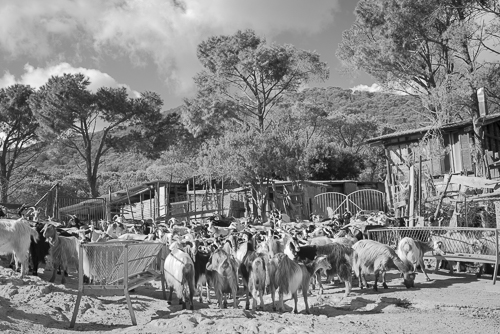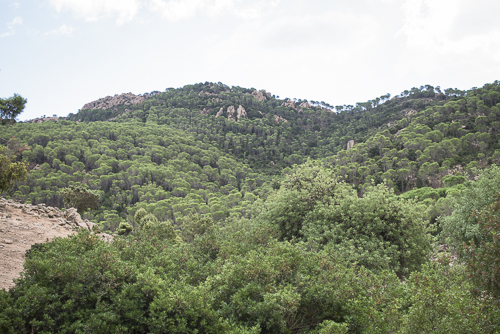Going from the town of Pula, we drove through a large pine forest planted by man during the fascist era in Italy (1924-1943) when large oak forests together with indigenous plants were cut down in order to provide wood for building railways. Anyway, the forest we’re passing through is pretty, with lots of green pine trees, valleys, and reddish granite peaks.
Having arrived at the parking space, we have to cross a small, dry riverbed before arriving at the goat farm at the top of a hillock. The view from the hillock is beautiful with a valley below and hills on the other side of the valley covered by bright, green pines in contrast with scattered, reddish columns of granite emerging between them and a brilliant, blue sky overhead.
Just below the hillock, in a clearing illuminated by the sun, a flock of goats is passing through a gate in the fence surrounding the farm, while the owner of the farm, Efisio Vargiu, talks about raising goats. In fact, he started following his father raising goats when he was a small boy, first for fun, since because he wanted it.
However, his father wanted to gradually reduce the number of goats and instead start cultivating a vineyard on his property along the alluvial plain of Santa Margherita di Pula. Instead, Efisio wanted to increase the size of the flock arriving at a total number of 500 goats.
Fortunately, Efisio is being helped doing this difficult, but captivating work by his son Giuseppe, both of them determined to continue the family tradition.
Nowadays, the size of the flock has been reduced to 190 individuals, all of whose names both Efisio and Giuseppe know by heart due to the affectionate tie between man and animal. The goats have names like: Cerexia, Bellina, Scamminada, Sposixedda, Scriana, Rubidosa, Anixedda… where the x is pronounced liked sh in e.g. ash.
Only an affectionate shepherd can remember 190 names and recognise the appearance of every animal of the flock, but it’s only through this mutual bond that they can work in harmony. Efisio says that he’s born for this type of work and he has never regretted his choice of work. Evidently, this activity should be sustained and even increased. Unfortunately, Efisio asks rhetorically why the politicians aren’t able to see and understand how difficult it is to even find a spare shepherd. In particular, he doesn’t understand why he has to pay for a concession to the state for using an area for letting his animals graze. This activity is heading towards extinction and as he mentions with bitterness: “We are very sad when we know that our animals are roaming freely in the forest for which we pay a concession. The goats are scared and put in danger by hunters who can use the same area without paying anything. They are free to walk around, shooting wild animals for sports, while we are working in order to make a living and to maintain a demanding and irreplaceable human activity.”
Today, father and son have arrived relatively late at the pen because at this time of the year the work is light, consisting of letting the goats enter the pen and feeding them what is required to complement the nourishment of the animals. The adult goats are all pregnant, leading to that they produce no or very little milk. Fortunately, both father and son are able to demonstrate that they can milk their goats by hand although the amount produced is minuscule. However, when the kids are born, the goats are milked since they produce more than their kids need and the milk is sold to dairies. However, the main income is given by the number of kids, which are born and survive. Both father and son have to be very attentive and help the goats in case of difficulty with the births. Naturally, the relation between man and animal gets even closer when the births are occurring.
According to Efisio, in addition to remembering all the names of the goats, a shepherd must also be able to recognise all the kids, which get the same name as their mothers.
In addition to having a mutually affectionate relation between man and animals, a shepherd also must be able to identify when the bucks are ready to mate (from June to September) and has to record the date when every goat has mated with a buck. From conception to birth takes 5 months minus 5 days, making Efisio and Giuseppe very alert when full term is approaching. In particular, if the goats are grazing far from the pen, a birth can be fatal for either goat or kid or even both of them, which would entail a major loss for the shepherds. Having recorded the date of conception, they can be present when the goats are about to give birth.
While explaining these details to us, Efisio watches smilingly his son because he’s so proud of him. He has an extraordinary ability to help the goats if they have problems giving birth to their kids, in particular when the kid is positioned awkwardly, Efisio says.
In spite of all the attention Efiso and Giuseppe are paying, sometimes a kid will be born far from the pen. In such cases, the goat stays with its kid, which has to rise up and walk to its mother in order to suckle. For the first three days, the kid’s paws grow rapidly more robust, but mother and kid stay together in the same place, else the kid can easily be killed by predators if it is left on its own. Then, when the kid is strong enough, they both walk back to the pen with the kid easily crossing rough terrain.
During the first 35-40 days of the kid’s life, it lives inside the pen and sleeps inside a small room made of wooden boards and lying on a bed of branches with dry leaves, protecting it from the cold and from predators. Every 24 hours, in the morning, the mother returns, letting her kid suckle. Unfortunately, the kids, which represent the major income of the farm, are destined for the market, while only a minor number of them are allowed to join the flock. A product much sought after is rennet, a typical cheese which doesn’t require any processing. It’s obtained by extracting the stomach of the kid after having suckled its mother for the last time just before it’s slaughtered. This type of cheese is smoked and sold together with the meat of the kid.


